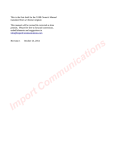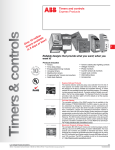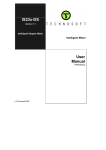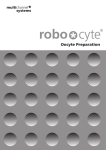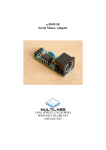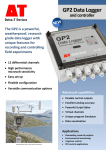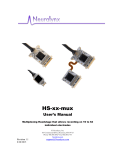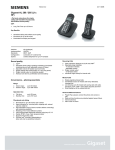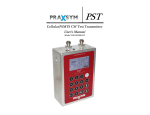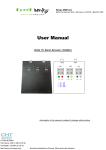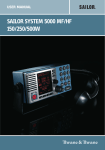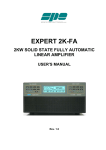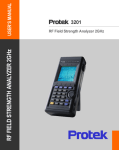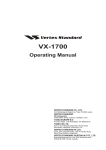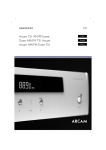Download User manual X-108G
Transcript
HF TRANSCEIVER X108G Operating Manual V1.0A Outdoor Edition Revise: 2015-07 Copyright © 2015, XIEGU, Inc. XIEGU TECH All Rights Reserved Security considerations: Important reminder: Before operating the equipment, please read our operating manual carefully and keep the manual, so as not to lose. Do not use equipment during a lightning Features: l Low noise, single conversion HF transceiver . storm. Double balanced diode mixer for extended dynamic range. l 0.25µV receive sensitivity (preamp on). l Narrow band double tuned bandpass filters covering all HF amateur frequencies including WARC bands. Built NC APC circuit. Circuit standard with high quality 0.5ppm TCXO clock source. 500 MHz narrow band CW filter configuration. l l l Damp-proof ! Don't illegal operations! Note RF high-voltage of antenna connector! ① vanning list: Qty ① ② ③ ④ ⑤ ② The main engine of the X 108G.....1 Power supply cable...........1 Hand microphone..............1 USB Cable...........1 Service card.................1 ⑤ ③ ④ ~2~ 一、Machine parameters Basic parameters Frequency range: Receive: Transmitting: 0.5~30MHz(Continuous) All HF Amateur bands including WARC bands Operating mode: SSB(J3E) CW (A1A) AM (A3E) minimum frequency stepping: 1Hz Antenna impedance: 50Ω Operating temperature range: -10℃ ~ +60℃ Frequency stability: ±0.5ppm @ Open the power about 5 minute , -10℃~+60℃ Operating voltage: Current draw: Receiving: Transmitting: 12~14.5V DC 600mA @Max 7.5A @ Max Dimensions (mm): 120*45*180(mm) [Does not include the Front and rear handles and the Knob etc bulge.] Transmitter parameters Transmitter power:More than 15W(@13.8V) Modulation mode: SSB balanced modulation: AM Low level modulation Spurious response rejection: ≥40dBc Carrier suppression: ≥45dBc IF filter: SSB 2.4kHz(-6dB) CW 500Hz(-6dB) Receiving parameters IF Frequency: receive sensitivity: 10.7MHz 0.5uV(PRE ON,≤2.0MHz) 0.3uV (PRE ON,>2.0MHz) Receive Frequency bands: 1.8~2.0MHz 3.5~4.0MHz 5.0~5.5MHz 7.0~7.3MHz 10.0~10.2MHz 14.0~14.5MHz 18.0~18.2MHz 21.0~21.6MHz 24.8~25.0MHz 28.0~28.8MHz 0.5~30.0MHz (*) ~3~ Dynamic range: Better than 90db RIT Frequency control range: ±1kHz audio output: 0.5W@8Ω 二、Description of equipment 2.1 Front panel Description 2.2 Rear panel Description ~4~ 1. SO-239 Antenna Jack. 2. AUX 3. External speaker output 4. CW key input. 5. ACC port. 6. USB port. 7. DC power input 8. Ground connection. 2.3 Microphone 1. 2. 3. 4. 5. 6. 7. 8. 9. 10. 11. 12. 13. Lock button/ Press it unlock again PTT button Up / Down frequency/channel Receiving indicator Multifunction Filter selection buttons Mode selection button No indication F1/F2 Custom set key Memory write button Frequency/Channel switching button VFO-A / VFO-B switching button No function 三、 Operating instructions 3.1 Screen displays instructions 【TS+】Increase frequency step 【TS-】Reduce frequency step ~5~ 【ATT】Switch receive signal attenuator on or off. 【PRE】Switch receive preamp on or off. 【MODE】 Select desired operating mode – CW/AM/LSB/USB. 【AGC】 Select AGC level – FAST/SLOW/OFF. 【NB】 Select NB level between 1 and 4. 【A/B】 Switch between VFO A & VFO B. 【A=B】 Set VFO A the same as VFO B. 【SPLT】 Select SPLIT operating mode. 【RIT】 Select RIT mode – adjust via selector knob B, setting shown on RIT display in OLED. 【POW】 Set RF output power – adjust via selector knob B, level displayed via red line in OLED 【V/M】 Select VFO or Memory mode. Select channel/frequency using selector knob B. 【M>V】In memory mode, move current frequency to VFO and switch to VFO mode. 【MW】In VFO mode, store current frequency and settings in memory. 【MC】In memory mode, clear selected memory channel. ~6~ 【FIL】Select filter 【KEY】 Select keyer – Manual/Auto L/Auto R. 【KSPD】Select keying speed - adjust via selector knob B, speed displayed under KEY in OLED 【TIME】Set Internal Clock – adjust via selector knob B, select hour/minute with Up/Down buttons. 【SQL】 Select to adjust Squelch level via selector knob B, level shown on line display in OLED. 【VCMP】voice compression settings 3.2.2: Mode Switching Method 1: Press the frequency knob to switch the current menu page, then press [MODE]. Press corresponding multifunction button, to complete mode switching. Method 2: On the multifunction digital microphone in hand, press to complete the mode switching. 3.2.3: Filter Switching Method 1: Press the frequency knob to switch the current menu page, then press [BW]. Press corresponding multifunction button to complete filter switching. Method 2: On the multifunction digital microphone in hand, press to complete filter switching. ~7~ 3.2.4: Preamplifier on/off Press the frequency knob to switch the current menu page, then press [PRE]. When the preamplifier is on, PRE will be highlighted green. When the preamplifier is off, PRE will appear dark. 3.2.5: Attenuator on/off Press the frequency knob to switch the current menu page, then press [ATT]. When the attenuator is on, ATT will be highlighted green. When the attenuator is off, ATT will appear dark. The attenuator provides 10 dB attenuation. 3.2.6: Automatic Gain Control on/off Press the frequency knob to switch the current menu page, then press [AGC]. AGC options are Fast or Slow with the screen showing the current status. Press [AGC] again to exit. 3.2.7: Noise Blanker on/off (if equipped) Press the frequency knob to switch the current menu page, then press [NB]. The Noise Blanker offers depth of NB1 thru NB4, with the screen showing the current status. 3.2.8: Switching between VFO-A / VFO-B Press the frequency knob to switch the current menu page, then press [A/B]. You can toggle between VFO-A and VFO-B. 3.2.9: Set both VFO's to the same settings Press the frequency knob to switch the current menu page, then press [A=B]. The settings of the current VFO will transfer to the second VFO. 3.2.10: Split frequency operations Press the frequency knob to switch the current menu page, then press [SPLIT]. ~8~ The radio will receive on VFO-A and transmit on VFO-B. 3.2.11: RIT tuning Press the frequency knob to switch the current menu page, then press [RIT]. Turning the frequency knob will change the receive frequency but leave the transmit frequency unchanged. Pressing [RIT] again will exit this mode. 3.2.12: Transmit power setting Press the frequency knob to switch the current menu page, then press [POW]. The on-screen power status will be highlighted. Rotate the frequency knob to select the desired power setting and press [POW] to exit. 3.2.13: Switching between Frequency Mode / Channel Mode Press the frequency knob to switch the current menu page, then press [V/M]. Press this function key to move between frequency mode and channel mode. 3.2.14: Move current channel to VFO Press the frequency knob to switch the current menu page, then press [M>V]. The radio will switch to VFO mode, showing information from the current channel. 3.2.15: Save current settings to Memory Press the frequency knob to switch the current menu page, then press [V/M] to choose channel mode. Turn the frequency knob until “BLANK” is highlighted. Press [V/M] to return to frequency mode. Adjust frequency, operating mode and other parameters desired, then press [MW] to write this information to memory. 3.2.16: Delete the current channel Press the frequency knob to switch the current menu page, then press [MC] to clear ~9~ the information stored in the current channel. 3.2.17: Manual / automatic telegraph key Press the frequency knob to switch the current menu page, then press [KEY]. Choose Manual Key, Automatic Left Hand telegraph key or Automatic Right Hand telegraph key. 3.2.18: Automatic telegraph key rate Press the frequency knob to switch the current menu page, then press [KSPD]. Turn the frequency knob to set the automatic key rate. 3.2.19: Set the local time Press the frequency knob to switch the current menu page, then press [TIME]. Then press the corresponding number keys on the microphone to set the local time. 3.2.20: Setting squelch level Press the frequency knob to switch the current menu page, then press [SQL]. Turn the frequency knob to set the squelch depth. Press [SQL] again to save the squelch setting and exit. 3.2.21: Set voice (speech) compression ratio Press the frequency knob to switch the current menu page, then press [VCMP]. Adjust the compression ratio as desired. 3.2.22 HRD Software When you connect your computer by the HDR, you can select IC7000 model to operating. ~ 10 ~ 3.3 Extended Interface 【AUX】No function 【SPK】External speaker output Speaker or Headphone(3.5 stereo Socket); Otherwise it will damage the rig. Before using the headphone, please decrease the volume. 【KEYER】Telegraph Key The telegraph key is automatic and manual integration. You can switch in the menu. 【ACC】ACC port Pin Definitions 1: 9V Power Output 2: PTT Signal Output 3: Wave Bands voltage output 4: ALC voltage output 5: External Audio input 6: Ground ~ 11 ~ Band voltage parameter 【USB】USB port PC control or firmware update 【DC IN】 Power port Power socket polarity, as shown: Note: Power input range: 12~14.5V DC Do not exceed the input voltage range and Reverse Access to power power. 【Ground hole】 【Ground screw】 3.4.Advanced Menu Settings CAUTION: THESE SETTINGS ARE DIRECTLY RELATED TO THE CORRECT OPERATION OF THIS RADIO. PLEASE EXERCISE CAUTION. PLEASE RECORD AND SAVE ALL ORIGINAL FACTORY SETTINGS BEFORE MAKING ANY ADJUSTMENTS. ~ 12 ~ To enter menu setting mode: Power off radio. Press and hold F1 button while powering on. 1. IF SSB: SSB IF 2. IF CW: CW IF 3. BFO LSB: BFO value LSB mode 4. BFO USB: BFO value USB mode 5. BFO CW: BFO value of the CW mode 6. CW Tone: CW side tone pitch frequency adjustment 7. CW TDly: CW launch delay 8. TOT: 9. Britns: 10. DDSCLK: System Clock 11. DCLKx6: DDS multiplier settings 12. System Audio Settings 13. F1 Custom set key 14. F2 Custom set key Item 1 to 5, cannot be freely modified, otherwise it will lead to the transceiver exception or even not work. Item 6, for CW Receiving side tone pitch adjustment. Users can according to their preferences and habits, adjusting CW side tone. Item 7, for CW transceiver delay. Users can operate according to their own habits, appropriate changes this parameter to match the transmitters speed. Item 12, Audio settings for the system, If the system beep or CW side tone is too high, then you can to adjust your volume size by item. n Press the frequency Key, choose current item. n Press the "up" or "down" button in the Mic, can select different items. n Via the Mic keypad Can direct input any value. n After setting, press save key to save and to automatic withdrawal. n If press Exit , not save. ~ 13 ~ After sales service policy Our company will promise to purchase the products of the company's, which are the products of the Chongqing Xiegu Technology Co., ltd.: Period of warranty is 1 year after date of purchase. 1. 0 - 10 days. If a radio arrives at customer's location in not-working condition (dead on arrival), the radio will be returned to the dealer. The dealer will ship a replacement radio to the customer. 2.10 days - 1 year. A defective radio during this time period will be returned by the customer to Xiegu via Xiegu DHL account. The customer need to provide these information: full name, address, telephone, postal encoding etc. to our e-mail: [email protected]. We will contact customer as soon as possible. If the defect is a factory defect, the radio will be repaired and returned to the customer free of shipping charges. If the defect has been caused by the customer, Xiegu will inform the customer and tell the customer the costs for the repair plus the cost for the return shipping. The customer will pay the costs directly to Xiegu via PayPal : [email protected] Xiegu will not return the radio until the repair costs is paid. 3. beyond 1 year. Any defective radio 1 year of age, will be repaired by Xiegu. After Xiegu receives the radio, we will send the customer an estimate of the repair costs. The costs for repair plus the shipping costs will be paid by the customer directly to Xiegu before the radio is returned to the customer. We will be in accordance with the customer's purchase invoice date as the standard, calculate the use time of the product and we'll be in accordance with the warranty card which the customer back to us to repair the product. Xiegu Technology Co.,Ltd. ~ 14 ~ XIEGU TECH 无线科技,无限创造 www.cqxiegu.com ~ 15 ~
















